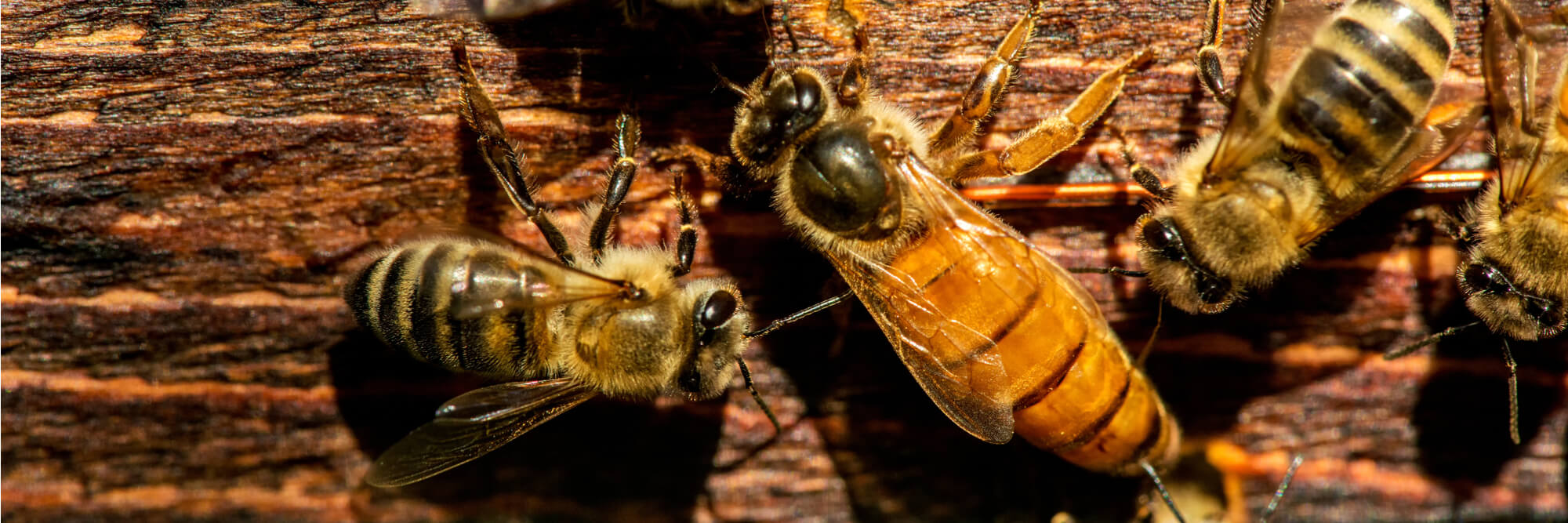Honey bees are social insects, living in colonies where different types of honey bees in the hive complete specific tasks. In this article, we’ll go over the basic honey bee biology and the differences between queens, drones and worker bees.

An Introduction to Honey Bee Biology
Honey bee colonies contain three distinct types, or castes, of individuals. Each hive contains a single female queen, tens of thousands of female workers, and anywhere from several hundred to several thousand male drones during the spring and summer months.
Honey Bee Castes: Queen Bees
Queen bees are the largest individuals in most colonies and carry out many important functions in the hive. The queen is responsible for laying a constant supply of eggs to build up and maintain the hive’s population at adequate numbers. In a good year, a queen may lay as many as 200,000 eggs!
The queen also produces chemicals called pheromones that control and organize many of the behaviors of her colony. Each queen has her own distinct pheromone profile, which allows her colony to recognize her, defend her and meet her needs to keep the hive safe and strong.
Honey Bee Castes: Worker Bees
Worker bees are by far the most numerous caste in hives and, as their name implies, carry out all of the work needed to keep the colony fed and healthy. During their first days as mature adults, workers tend to perform tasks inside the hive, such as cleaning and capping cells.
As they mature, worker bees begin to perform more tasks inside the hive, including feeding the queen and developing brood, drawing out new comb, and managing food stores. The oldest and most experienced workers tend to perform the most dangerous chores: guarding the hive against intruders and foraging outside the hive for pollen and nectar.
Honey Bee Castes: Drone Bees
The only males found in the hive, drones perform only one task during their lifetime: mating with new queens. When a drone reaches sexual maturity at about two weeks of age, he begins taking mating flights. These flights usually take place in spring and summer afternoons and last about 30 minutes.
Newly matured queens and drones from several hives typically join in these flights. In most instances, the queens mate with multiple drones and store the drones’ sperm in an organ called the spermatheca. The queen will then use this stored genetic material to fertilize her eggs for the rest of her life.
What Makes a Queen?
After a successful mating flight, queens begin laying eggs that develop into the new brood. Two factors determine the caste of the developing brood. The first is whether the queen fertilized the egg, the second is the type and amount of feeding the larva receive in the first few days of development.
Unfertilized eggs develop into males that become drones, while fertilized eggs develop into the female brood. The type and volume of food these female broods receive from glands in the hive’s nurse bees determine whether they become workers or a new queen.
Brood destined to become workers feed on smaller amounts of secretions from the hypopharyngeal glands of nurse bees and, in the last few days of development, honey and pollen. Those destined to become queens feed on larger amounts of a secretion known as royal jelly, produced by the nurse bees’ mandibular glands.
Developmental Stages of Honey Bees
No matter which caste they become, all honey bees progress through the same basic stages of growth. The first of these is the egg stage. As mentioned above, the colony’s lone queen lays the eggs. There are a few circumstances that will cause workers to lay eggs as well, but by and large, the queen handles this task.
After approximately three days the egg hatches and the bee enters the larval stage. This stage is all about eating the secretions from the hive’s nurse bees and growing rapidly. Indeed, the larva is not much more than a mouth and a digestive tract! At the end of this growth stage, which lasts four to six days, the bee enters the prepupal stage where worker bees cap the cell with beeswax and the larva covers itself in silk.
Wrapped in their cocoon and safely capped in their cell, the bee next enters the pupa stage. This is when the bee makes its amazing transformation from a worm-like larva into what we think of as a bee. During this stage, the bee develops legs, wings, and other functional body parts. Near the end of this transformation, the new bee chews through the cap of their cell and enters the adult stage where they will carry out the role of their given caste.
Stay tuned for our next article where we’ll discuss how beekeepers harness this knowledge of honey bee biology to rear queens for new hives!
Have questions? Give us a call at 888.922.1293 or contact the closest Dadant branch.
For beekeeping equipment and educational materials, visit our online store.